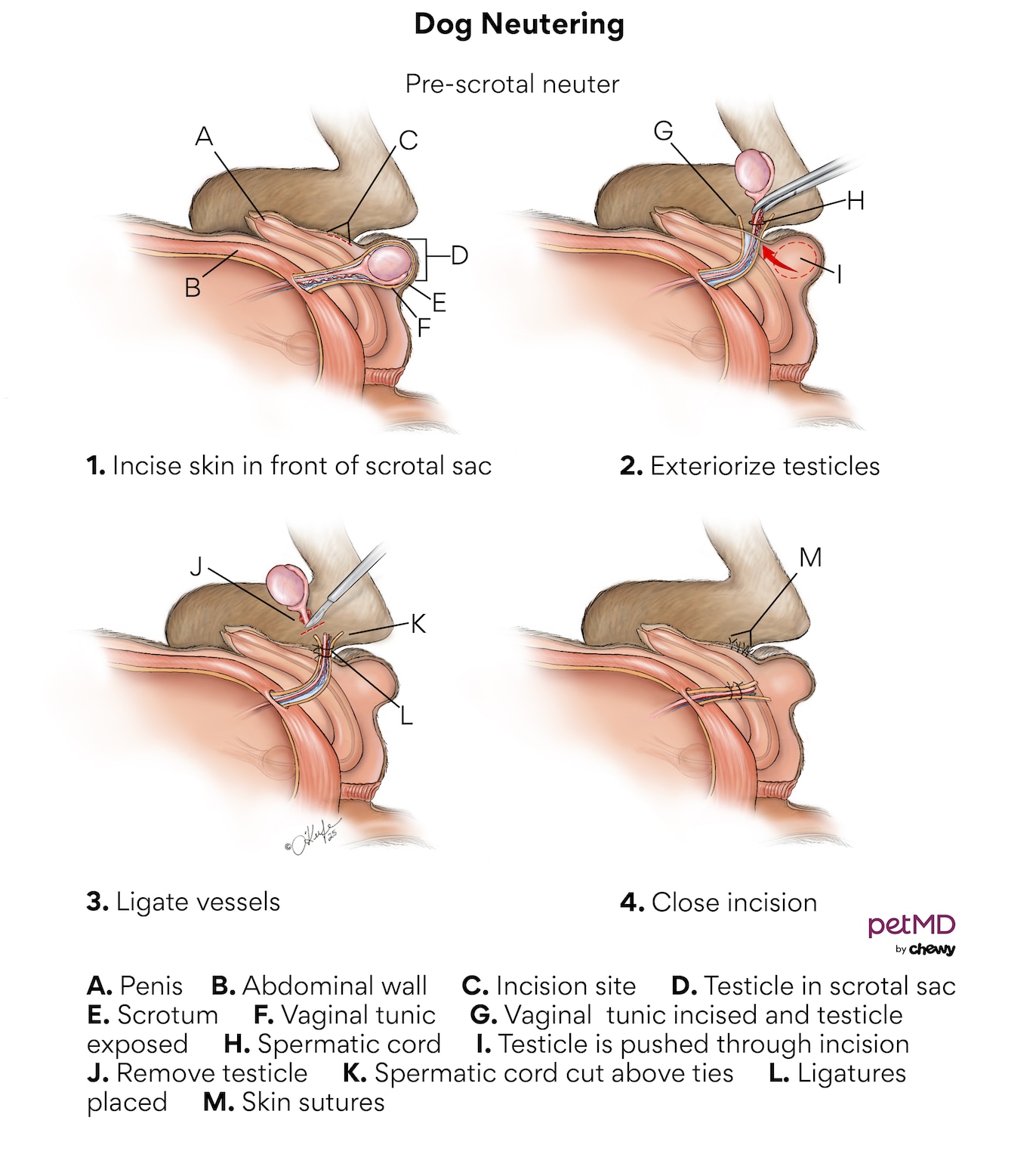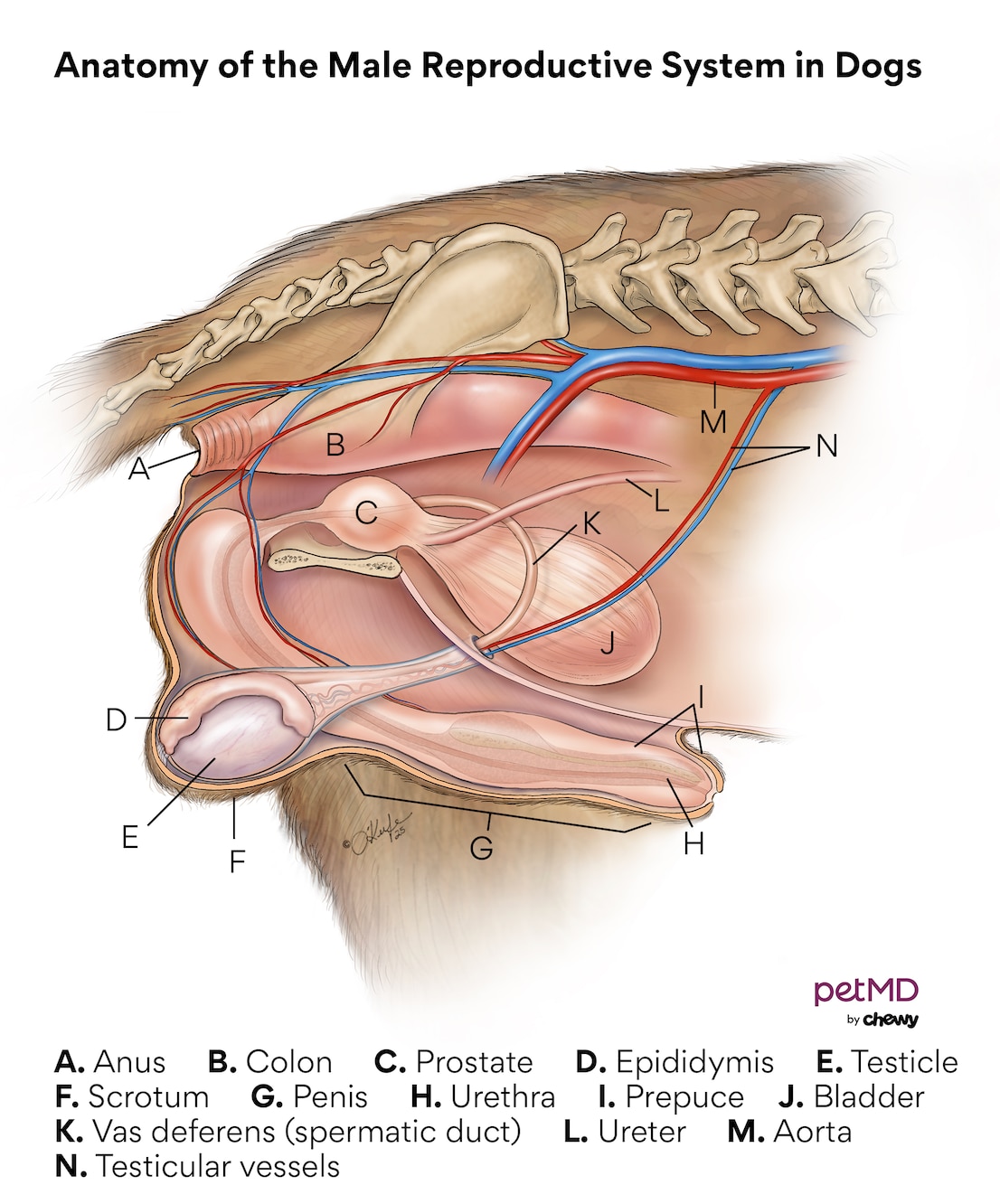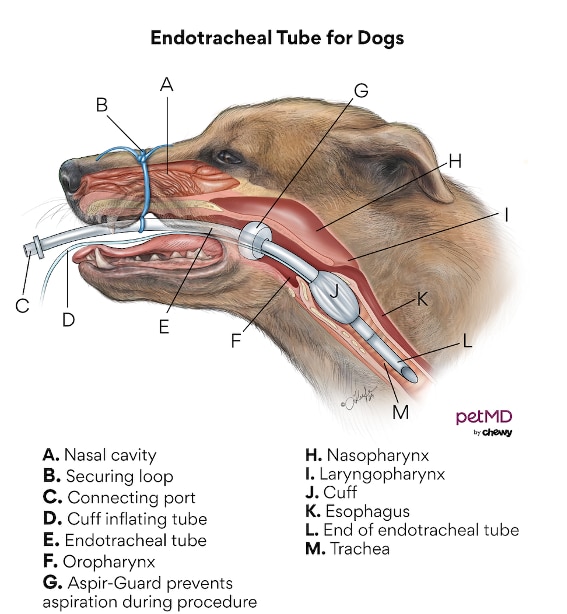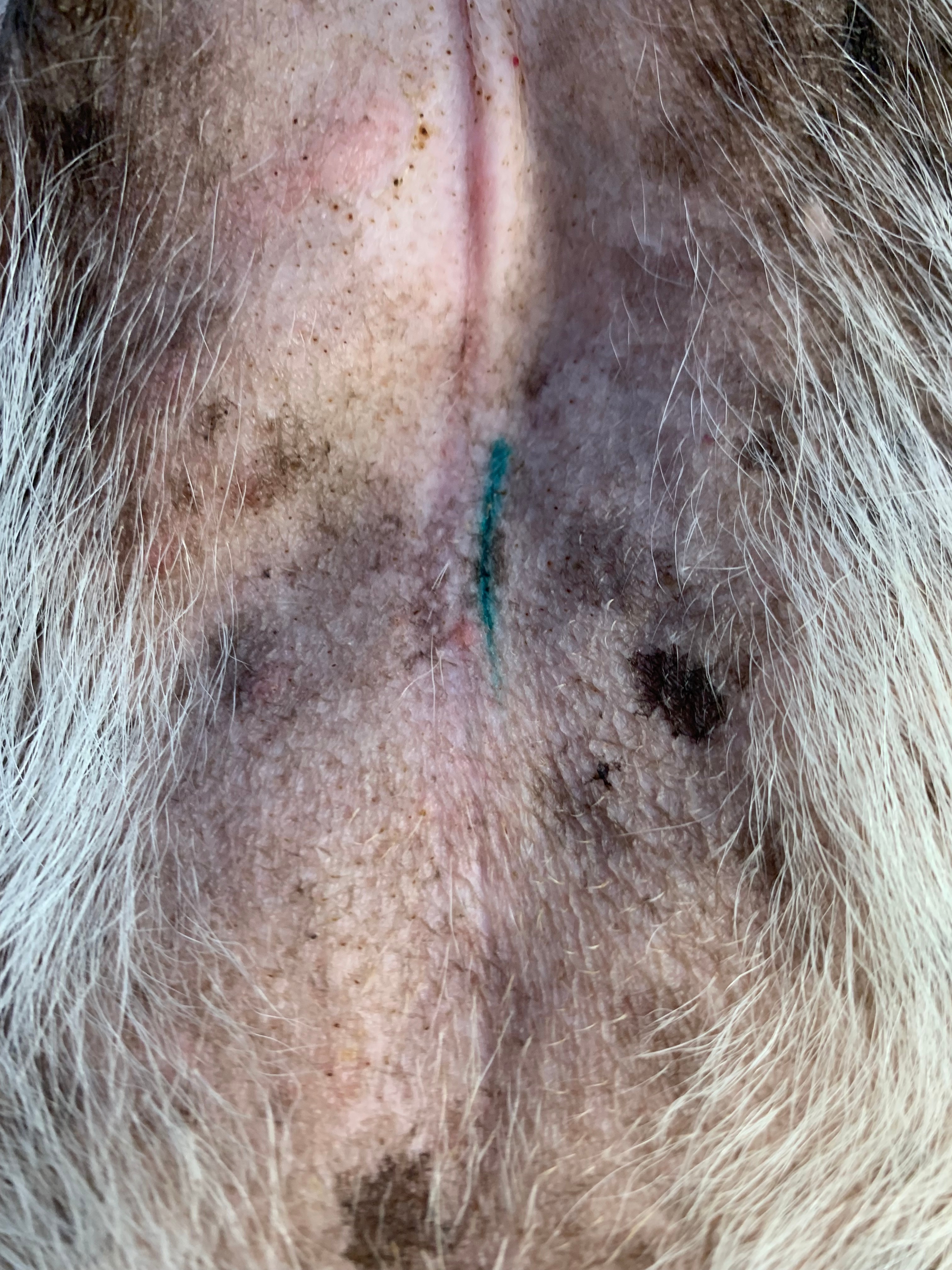Dog Neutering: Everything You Need To Know
Adam Bartosik/iStock / Getty Images Plus via Getty Images
What Is Dog Neutering?
Dog neutering is a surgery done to ensure a male dog can’t reproduce.
In dogs, the term “neuter” means the same thing as castration. During the neuter procedure, a male dog’s testicles are removed.
The neuter procedure is done under general anesthesia so that the dog doesn’t feel any pain during the surgery.
A neuter is the most common surgery for male dogs, with most pet dogs having the procedure. The age at which a dog should be neutered is still somewhat controversial, and research is ongoing.

Click here to download this medical illustration.
Shelters will do neuters in dogs as young as 2 months old because shelters play an important role in reducing pet overpopulation. Many local governments don’t allow shelters to adopt out unneutered animals.
For pets, the recommended age to neuter is usually based on expected adult size. Small-breed dogs are often neutered around 6 months old.
Medium-to large-breed dogs may be neutered between 6 months to 1 year old. Some giant breed dogs aren’t neutered until they’re closer to 18 months of age.
Despite these general guidelines, when to neuter a dog should be considered on an individual basis.
Pet parents who plan to get their dog neutered should discuss timing with their veterinarian.
Anatomy of the Male Reproductive System in Dogs
The male dog has two testicles within their scrotum, which is found between their back legs. The testicles produce sperm and male sex hormones, like testosterone.
Testosterone is the hormone responsible for the function of sex glands like the prostate, the development of male characteristics, and sexual behavior in male dogs.
Each testicle has an epididymis, which is where sperm mature.
On each side, the epididymis is connected to a tube called the vas deferens. The vas deferens carries ejaculated sperm to the urethra.
The fluid part of semen comes from the other sex glands, mainly the prostate. The two vasa deferentia join the urethra in the area of the prostate gland.
The urethra will carry semen out through the dog’s penis. The penis has skin covering it, which is called the prepuce. When the dog has an erection, the penis will enlarge and stick out from the prepuce, allowing the male dog to mate.

Click here to download this medical illustration.
During a dog neutering procedure, an incision (cut) is made either directly into the scrotum (scrotal technique) or into the skin between the prepuce and scrotum (prescrotal technique).
For both techniques, the testicles are removed through the incision.
Why Would a Dog Need To Be Neutered?
There are two main reasons a dog should be neutered:
-
Prevention of reproduction
-
Prevention of unwanted male behaviors
A neutered dog cannot breed. He will be unable to get a female dog pregnant.
A neutered dog is also less likely to urine mark and to be aggressive. He will not try to escape to find mates.
Occasionally, a dog may be cryptorchid. This means one or both testicles did not come down into the scrotum.
While a cryptorchid testicle generally doesn’t make working sperm, it will continue to make testosterone. The dog will have the unwanted traits seen with intact male dogs, such as marking and escaping to find mates.
Cryptorchid testicles are also much more likely to become cancerous. Cryptorchid dogs should be neutered and should not be allowed to reproduce.
Dogs may also be neutered because of testicular tumors or tumors around their anus (perianal adenomas).
Benefits of Dog Neutering
Benefits of dog neutering include:
-
Removes risk of accidental pregnancy of female dogs in home
-
Helps with pet overpopulation
-
Reduces unwanted male behaviors, such as escaping to find mates and urine marking
-
Reduces risk of traumatic injury and contracting infectious disease while roaming
-
Leads to a longer average lifespan due to fewer injuries and infections
-
Removes risk for testicular cancer
Effectiveness of Dog Neutering
Dog neutering is highly effective. When a dog has a successful neuter procedure, there is no chance of him getting a female dog pregnant.
While neutering can reduce unwanted male behaviors, it’s most effective for this purpose if done before the male behaviors develop.
Although some dogs neutered later in life will stop urine marking within the home, a dog who is neutered before the behavior starts is less likely to ever urine mark.
Dogs who have had urine marking, aggression, or other unwanted behaviors reinforced may not stop after being neutered.
However, neutering will completely remove the desire to seek out mates, reducing roaming behavior. This decreases the pet’s risk of getting an infectious disease or being struck by a vehicle.
This is thought to be the reason that neutered males have longer lifespans than intact males.
Cost of Dog Neutering
A routine dog neutering at a private practice is likely to cost $300 to $500.
Some low-cost or non-profit clinics have a much lower dog neutering cost. Occasionally, these clinics may hold free neuter events.
The cost will be higher if the dog is cryptorchid, especially if the veterinarian must search in the abdomen for the testicle or testicles.
Preparation for Dog Neutering
Pet parents will be asked to fast their dog for the night before dog neutering surgery to reduce their risk of vomiting while under anesthesia.
Many veterinarians will still allow your dog to drink water prior to surgery, but you should check with your pet’s veterinarian. A pet parent can also prepare for the surgery by having a plan in place for the recovery period (more below).
At the hospital, the dog is anesthetized for the surgery.
The scrotum and the area in front of the scrotum are shaved to allow for a clean incision. In some cases, your dog will have a catheter put in place to allow fluids and medications to be given.
Your dog will have a tube in his trachea (windpipe) or a mask on his face so he can get oxygen and gas anesthetics.

Click here to download this medical illustration.
Some clinics have a standard rule to tattoo all neutered or spayed animals. This marks your pet as altered. A tattoo removes doubt about whether he has been neutered or is a bilateral cryptorchid.

Complications of Dog Neutering
Common complications of a dog neuter include:
-
Bleeding
-
Scrotal swelling (scrotal hematoma)
Dog neutering is an anesthetic procedure. As such, there are potential complications from anesthesia, including inhaling vomit, allergic reaction to anesthetics, or cardiac arrest leading to death.
The risk of death during a neuter procedure is very low, with one study of more than 89,000 dogs showing a risk of 0.009%, or around 1 death per 11,000 dogs.
Research into how dog neutering affects the development of orthopedic conditions and cancers later in life is ongoing.
Examples of orthopedic conditions being investigated include cranial cruciate ligament rupture (torn ACL) and hip dysplasia.
Examples of cancers being studied include:
Neutered dogs are more likely to become obese, so your pet’s weight should be watched.
While some correlations have been found between neutered dogs and these risks, causation has not been proven.
Post-Op Care and Recovery for Dog Neutering
Your dog is likely to be tired and may have a reduced appetite for a day after surgery. Your dog’s appetite and energy level should return to normal within about two days.
Your pet should go home with pain medications, such as carprofen.
It’s important to follow your veterinarian’s instructions for how to give any medications. Do not use pain medications meant for people.
Mild swelling of the scrotum and a small amount of blood after dog neutering are to be expected.
However, you should contact your veterinarian if you notice:
-
Blood dripping from the incision
-
Bruising extending up toward the foreskin
-
Large, firm swelling of the scrotum
-
Pus around the incision
-
The incision breaking open
The best thing you can do while your dog is recovering from his neuter is to prevent him from licking the incision.
Licking the incision is the primary reason it can become infected. Placing a recovery cone on your dog can prevent this complication.
Some dogs can reach their neuter incision when a doughnut-type cone is placed. Make sure that your dog's cone prevents him from reaching his incision.
The incision can take 10 to 14 days to heal. Do not allow the incision to get wet during this time.
Alternatives to Dog Neutering
Most veterinary clinics do not offer alternatives to dog neutering. However, there are a couple of options.
A vasectomy can be done on a dog to make him infertile, but the dog will continue to show testosterone-driven behaviors. He will continue to be attracted to and mate with females but won’t be able to get them pregnant.
It’s important to follow your veterinarian’s instructions for how to give any medications. Do not use pain medications meant for people.
Another way is having a sterilant (calcium chloride) injected into the testicle. Like a vasectomy, this will make the dog infertile. If it’s done correctly, he will still make male hormones.
This chemical sterilization procedure is very rare.
Dog Neutering FAQs
What is the best age to neuter a male dog?
The best age to neuter a male dog depends on the individual pet and their expected adult size.
Small dogs are often neutered around 6 months old, while giant-breed dogs are often not neutered until they are 18 months old.
Speak with your veterinarian to figure out the best plan for your pet.
Do male dogs change after being neutered?
Male dogs will often have a decrease in unwanted male behaviors after being neutered. Neutered males are less likely to roam in search of mates, to show aggression toward their pet parents, and to urine mark.
Is neutering good for dogs?
Neutering increases the overall lifespan of most dogs, with one study showing a 13.8% increase in lifespan for neutered males compared with intact males.
It reduces the risk of certain cancers, infectious diseases, and death by traumatic injury.
However, neutering may also increase the risk of certain orthopedic conditions and cancers. Research is ongoing, but for now, neutering is considered positive due to an overall increase in lifespan.
